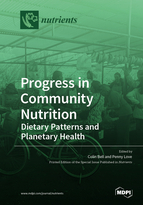Progress in Community Nutrition: Dietary Patterns and Planetary Health
A special issue of Nutrients (ISSN 2072-6643). This special issue belongs to the section "Nutrition and Public Health".
Deadline for manuscript submissions: closed (15 August 2022) | Viewed by 41202
Special Issue Editors
Interests: non-communicable disease prevention and control; nutrition epidemiology; intervention design; delivery and evaluation; health promotion; childhood obesity prevention; program management; creating healthy environments
Interests: childhood obesity prevention; knowledge translation and exchange; socioecological approaches to obesity prevention; food security issues; cross-cultural nutrition practices; food-based dietary guidelines
Special Issue Information
Dear colleagues,
Dietary patterns are evolving, and we are increasingly aware of the contribution of food and food systems to community and planetary health. To be responsive to these changes and to promote dietary patterns that enhance the health and wellbeing of populations and protect against climate change, nutrition professionals and researchers need to monitor evolving dietary patterns and trial comprehensive, multiaction solutions.
This Special Issue will focus on research that describes comprehensive approaches to nutrition surveillance, epidemiological studies of diet, the development, implementation, and evaluation of dietary recommendations and goals, interventions to improve access and availability of healthy foods and interventions to strengthen food literacy, and sustainable dietary patterns among populations and health professionals.
Prof. Dr. Colin Bell
Guest Editor
Dr. Penelope Love
Co-Guest Editor
Manuscript Submission Information
Manuscripts should be submitted online at www.mdpi.com by registering and logging in to this website. Once you are registered, click here to go to the submission form. Manuscripts can be submitted until the deadline. All submissions that pass pre-check are peer-reviewed. Accepted papers will be published continuously in the journal (as soon as accepted) and will be listed together on the special issue website. Research articles, review articles as well as short communications are invited. For planned papers, a title and short abstract (about 100 words) can be sent to the Editorial Office for announcement on this website.
Submitted manuscripts should not have been published previously, nor be under consideration for publication elsewhere (except conference proceedings papers). All manuscripts are thoroughly refereed through a single-blind peer-review process. A guide for authors and other relevant information for submission of manuscripts is available on the Instructions for Authors page. Nutrients is an international peer-reviewed open access semimonthly journal published by MDPI.
Please visit the Instructions for Authors page before submitting a manuscript. The Article Processing Charge (APC) for publication in this open access journal is 2900 CHF (Swiss Francs). Submitted papers should be well formatted and use good English. Authors may use MDPI's English editing service prior to publication or during author revisions.
Keywords
- community nutrition
- planetary health
- food
- dietary patterns
- nutrition epidemiology
- nutrition interventions
- food literacy







